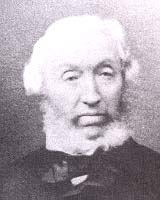Anthony Salvin
| Anthony Salvin | |
|---|---|

Anthony Salvin
|
|
| Born | 17 October 1799 Sunderland Bridge, County Durham, England |
| Died | 17 December 1881 (aged 82) Fernhurst, Sussex, England |
| Nationality | English |
| Occupation | Architect |
| Known for |
Tudor style architecture Restoration of castles, country houses and churches New houses and churches |
| Children | Osbert Salvin |
Anthony Salvin (17 October 1799 – 17 December 1881) was an English architect. He gained a reputation as an expert on medieval buildings and applied this expertise to his new buildings and his restorations. He restored castles and country houses, and built a number of new houses and churches.
He was born in Sunderland Bridge, County Durham, as the only child of General Anthony Salvin, a soldier, and his second wife Elizabeth (Eliza) Mills. He was educated at Durham School and in 1820 became a pupil of John Paterson of Edinburgh while he was working on the restoration of Brancepeth Castle in County Durham.
In 1821 Salvin moved to London. He had an introduction to Sir John Soane but did not enter his office. According to his nephew he entered the office of John Nash. In 1824 he was elected as a fellow of the Society of Antiquaries. Soon after this he went on a sketching tour of Great Britain. On 26 July 1826 he married his cousin, Anne Andrews Nesfield. With her he had six children, two of whom died in infancy.
Salvin's first major commission was Mamhead Park in Devon for Robert William Newman. This was designed in the Tudor style to a symmetrical plan. It was adapted from a plan by Charles Fowler and this placed restrictions on his design. His next design was for Moreby Hall in the East Riding of Yorkshire for Henry Preston where he was free to develop a complete design in the Tudor style, again on a symmetrical plan. At Scotney Castle in Kent he designed for Edward Hussey an asymmetrical design in the Tudor style. In 1831 Salvin embarked on what is considered to be his most important early domestic work at Harlaxton Manor in Lincolnshire for Gregory Gregory. Salvin's design combined elements from Montacute House in Somerset and Hengrave Hall in Suffolk. However, before the building was complete, Salvin was replaced as architect by William Burn. In 1835 Salvin spent five weeks in Germany.
...
Wikipedia
